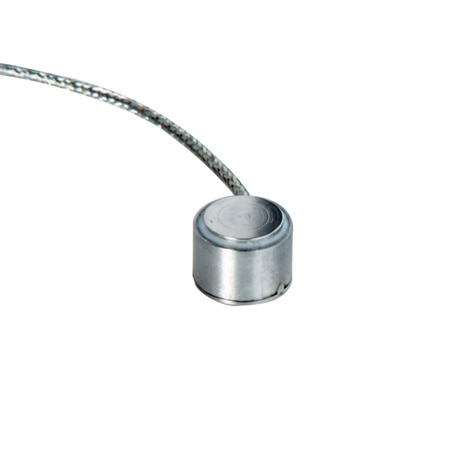Welcome to our new website, found an issue or bug? Please report it here

LC307
Top Hat Style, Miniature Compression Load Cell
Models In Stock
- All Stainless Steel Construction
- Built-in Load Button for Easy Installation
- Rugged, Heavy Duty Design
- 5-Point Calibration with 90 kOhm Shunt Cal Data
LC307
From
$
669.07
Models In Stock
Product Overview
- 5-Point Calibration 0%, 50%, 100%, 50%, 0%
- Accuracy ± 0.75 %
- Bridge Resistance 350 Ω
- Cable Length 5 ft
- Calibration Option 5 POINT NIST
- Electrical Connection Cable
- Electrical Output 1.75 mV/V
- Enclosure Ratings IP54
- Force Type Compression
- Full Scale Deflection 0.003 in
- Hysteresis 0.0075
- Linearity ± 0.75%
- Load Cell Type Top Hat
- Materials Stainless Steel
- Operating Temperature, Max 121 °C
- Operating Temperature, Min -54 °C
- Overload, Max 300% FS
- Process Temperature, Max 71 °C
- Process Temperature, Min 16 °C
- Repeatability 0.0075
- Safe Overload 150% FS
- Supply Voltage 5 Vdc
- Thermal Span Effect ± 0.018% FSO/°C
- Thermal Zero Effect ± 0.018% rdg/°C
- Wiring/Connector Table Green: (-) Output; White: (+) Output; Black: (-) Input; Red: (+) Input
- Zero/Balance Error ± 2%
Small in size but not in performance, the Series LC307 "Top Hat" load cell is designed for applications with minimum space and high capacity loads up to 100,000 lb. Rugged all stainless steel construction and high performance strain gages assure superior linearity and stability. Temperature compensation is achieved through a miniature circuit board in the load cell’s cable. This unit is designed to be mounted on a smooth, flat surface.
The LC307 is also available in metric configurations, with 0-1 to 0-500 kN ranges. Please see the LCM307 for complete details, or contact our Pressure department for more information..
SPECIFICATIONS
Excitation: 5 Vdc
Output: 1.75 mV/V nominal
Accuracy: 0.75% FS BFSL (includes linearity, hysteresis and repeatability)
Zero Balance: ± 2% FSO
Operating Temp Range: -54 to 121°C (-65 to 250°F)
Compensated Temp Range: 16 to 71°C (60 to 160°F)
Thermal Effects:
Span: ± 0.018% rdg/°C
Zero: ± 0.018% FSO/°C
Safe Overload: 150% of capacity
Ultimate Overload: 300% of capacity
Bridge Resistance: 350Ω minimum
Full Scale Deflection: 0.025 to 0.076 mm (0.001 to 0.003")
The LC307 is also available in metric configurations, with 0-1 to 0-500 kN ranges. Please see the LCM307 for complete details, or contact our Pressure department for more information..
SPECIFICATIONS
Excitation: 5 Vdc
Output: 1.75 mV/V nominal
Accuracy: 0.75% FS BFSL (includes linearity, hysteresis and repeatability)
Zero Balance: ± 2% FSO
Operating Temp Range: -54 to 121°C (-65 to 250°F)
Compensated Temp Range: 16 to 71°C (60 to 160°F)
Thermal Effects:
Span: ± 0.018% rdg/°C
Zero: ± 0.018% FSO/°C
Safe Overload: 150% of capacity
Ultimate Overload: 300% of capacity
Bridge Resistance: 350Ω minimum
Full Scale Deflection: 0.025 to 0.076 mm (0.001 to 0.003")
PDFs & Manuals
Show Ratings & Reviews
Regarding "top-hat" load cell item LC307-500 lbf.; Please advise if you can provide the following information - A) What is the Maximum Power (Watt) Rating for this device B) What is the Thermal Resistance of the Device (degrees Celsius per Watt)
Power ratings for this .cell are a follows. Nominal Excitation Voltage is 5 VDC. Maximum current from power supply 15 mA. There is no for Thermal Resistance on this sensor.
Date published: 2021-05-19
Does the LC307 load cell transducer meet the requirements of a non-incendive apparatus and thus is it suitable for application use in a Division 2 hazardous location ?
The LC307 is not rated for hazardous location usage, please see the LCHD-IS load cells for use in a Division 2 hazardous location.
Date published: 2021-05-27
Which surface of the LC-307 load cell would be best held against a stationary surface and which surface is best to apply the load against ?
The SPHERICAL RADIUS shown on the dimensional drawing on the Datasheet is the loading surface that you would apply the load.
Date published: 2021-06-14
Is there any data about natural frequency of the sensor? I would like to use it for applications requiring high-frequency
These load cells are strain gage based (piezo-resistive) devices designed for static or slow changes in load. For high frequency applications a piezo-electric based device should be used. Omega does not offer piezo-electric based force sensors
Date published: 2023-05-31
This is a follow-up question for Application Engineer JK, regarding Thermal Resistance question. When you said "no" in your original answer, do you mean negligible Thermal Resistance? or did you mean no information is available?
There is no data available forThermal Resistance for our load cells
Date published: 2021-05-20
What is the minimum load (in lbf or other equivalent unit) that this sensor starts reading? Does it vary depending on the specific dash number? What would be this number for LC307-3K?
The sensor does actually start reading at very low loads but you should never rely on the accuracy of the reading in the lower 10% of it's load range. In the case of a 0 to 3000 lbf range load cell this be readings below the 300 lbf range
Date published: 2021-06-02